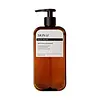What's inside
What's inside
 Key Ingredients
Key Ingredients

 Benefits
Benefits

 Concerns
Concerns

 Ingredients Side-by-side
Ingredients Side-by-side

Water
Skin ConditioningSodium C14-16 Olefin Sulfonate
CleansingSodium Cocoyl Alaninate
Disodium Cocoamphodiacetate
CleansingDipropylene Glycol
HumectantCocamide Methyl Mea
Sodium Chloride
MaskingPolyquaternium-47
Skin ConditioningLauryl Glucoside
CleansingPolyquaternium-7
Myristyl Alcohol
EmollientCaprylyl Glycol
EmollientHexyl Cinnamal
PerfumingLinalool
PerfumingTetrasodium EDTA
Citronellol
PerfumingGlutamic Acid
HumectantAspartic Acid
MaskingArginine
MaskingSodium Benzoate
MaskingEthylhexylglycerin
Skin ConditioningPanthenol
Skin ConditioningButylene Glycol
Humectant1,2-Hexanediol
Skin ConditioningHydroxypropyl Cyclodextrin
MaskingPolyquaternium-10
Salicylic Acid
MaskingDisodium EDTA
PCA
HumectantLactic Acid
BufferingGlucose
HumectantGlycine
BufferingUrea
BufferingSodium Glycerophosphate
Serine
MaskingPotassium Magnesium Aspartate
BufferingLeucine
Skin ConditioningAlanine
MaskingCalcium Gluconate
HumectantLysine
Skin ConditioningMagnesium Gluconate
Skin ConditioningAcetyl Glucosamine
Skin ConditioningProline
Skin ConditioningThreonine
Histidine
HumectantPhenylalanine
MaskingTyrosine
MaskingValine
MaskingIsoleucine
Skin ConditioningCreatine
Skin ConditioningUric Acid
BufferingCysteine
AntioxidantMethionine
Skin ConditioningWater, Sodium C14-16 Olefin Sulfonate, Sodium Cocoyl Alaninate, Disodium Cocoamphodiacetate, Dipropylene Glycol, Cocamide Methyl Mea, Sodium Chloride, Polyquaternium-47, Lauryl Glucoside, Polyquaternium-7, Myristyl Alcohol, Caprylyl Glycol, Hexyl Cinnamal, Linalool, Tetrasodium EDTA, Citronellol, Glutamic Acid, Aspartic Acid, Arginine, Sodium Benzoate, Ethylhexylglycerin, Panthenol, Butylene Glycol, 1,2-Hexanediol, Hydroxypropyl Cyclodextrin, Polyquaternium-10, Salicylic Acid, Disodium EDTA, PCA, Lactic Acid, Glucose, Glycine, Urea, Sodium Glycerophosphate, Serine, Potassium Magnesium Aspartate, Leucine, Alanine, Calcium Gluconate, Lysine, Magnesium Gluconate, Acetyl Glucosamine, Proline, Threonine, Histidine, Phenylalanine, Tyrosine, Valine, Isoleucine, Creatine, Uric Acid, Cysteine, Methionine
Water
Skin ConditioningCocamidopropyl Betaine
CleansingSorbitol
HumectantDisodium Laureth Sulfosuccinate
CleansingCocamide Methyl Mea
Sodium Chloride
MaskingDisodium Cocoamphodiacetate
CleansingCocamide Mea
Emulsifying1,2-Hexanediol
Skin ConditioningSodium Benzoate
MaskingCitric Acid
BufferingDisodium EDTA
Butylene Glycol
HumectantPanax Ginseng Root Water
MaskingOphiopogon Japonicus Root Extract
Skin ConditioningAngelica Acutiloba Root Extract
Skin ConditioningBupleurum Falcatum Root Extract
Skin ConditioningPerilla Ocymoides Seed Extract
AntioxidantNatto Gum
Ceramide NP
Skin ConditioningEthylhexylglycerin
Skin ConditioningStearic Acid
CleansingHydroxypropyl Bispalmitamide Mea
EmollientMannitol
HumectantAcrylates/Ammonium Methacrylate Copolymer
Silica
AbrasiveCholesterol
EmollientWater, Cocamidopropyl Betaine, Sorbitol, Disodium Laureth Sulfosuccinate, Cocamide Methyl Mea, Sodium Chloride, Disodium Cocoamphodiacetate, Cocamide Mea, 1,2-Hexanediol, Sodium Benzoate, Citric Acid, Disodium EDTA, Butylene Glycol, Panax Ginseng Root Water, Ophiopogon Japonicus Root Extract, Angelica Acutiloba Root Extract, Bupleurum Falcatum Root Extract, Perilla Ocymoides Seed Extract, Natto Gum, Ceramide NP, Ethylhexylglycerin, Stearic Acid, Hydroxypropyl Bispalmitamide Mea, Mannitol, Acrylates/Ammonium Methacrylate Copolymer, Silica, Cholesterol
 Reviews
Reviews

Ingredients Explained
These ingredients are found in both products.
Ingredients higher up in an ingredient list are typically present in a larger amount.
1,2-Hexanediol is a synthetic liquid and another multi-functional powerhouse.
It is a:
- Humectant, drawing moisture into the skin
- Emollient, helping to soften skin
- Solvent, dispersing and stabilizing formulas
- Preservative booster, enhancing the antimicrobial activity of other preservatives
Butylene Glycol (or BG) is used within cosmetic products for a few different reasons:
Overall, Butylene Glycol is a safe and well-rounded ingredient that works well with other ingredients.
Though this ingredient works well with most skin types, some people with sensitive skin may experience a reaction such as allergic rashes, closed comedones, or itchiness.
Learn more about Butylene GlycolWe don't have a description for Cocamide Methyl Mea yet.
Disodium Cocoamphodiacetate is a surfactant and helps cleanse skin. It is created from the fatty acids of coconut oil.
Surfactants help rinse oil, dirt, and other pollutants easily from skin. It has a faint fruit-like scent.
Disodium EDTA plays a role in making products more stable by aiding other preservatives.
It is a chelating agent, meaning it neutralizes metal ions that may be found in a product.
Disodium EDTA is a salt of edetic acid and is found to be safe in cosmetic ingredients.
Learn more about Disodium EDTAEthylhexylglycerin (we can't pronounce this either) is commonly used as a preservative and skin softener. It is derived from glyceryl.
You might see Ethylhexylglycerin often paired with other preservatives such as phenoxyethanol. Ethylhexylglycerin has been found to increase the effectiveness of these other preservatives.
Sodium Benzoate is a preservative. It's used in both cosmetic and food products to inhibit the growth of mold and bacteria. It is typically produced synthetically.
Both the US FDA and EU Health Committee have approved the use of sodium benzoate. In the US, levels of 0.1% (of the total product) are allowed.
Sodium benzoate works as a preservative by inhibiting the growth of bacteria inside of cells. It prevents the cell from fermenting a type of sugar using an enzyme called phosphofructokinase.
It is the salt of benzoic acid. Foods containing sodium benzoate include soda, salad dressings, condiments, fruit juices, wines, and snack foods.
Studies for using ascorbic acid and sodium benzoate in cosmetics are lacking, especially in skincare routines with multiple steps.
We always recommend speaking with a professional, such as a dermatologist, if you have any concerns.
Learn more about Sodium BenzoateChances are, you eat sodium chloride every day. Sodium Chloride is also known as table salt.
This ingredient has many purposes in skincare: thickener, emulsifier, and exfoliator.
You'll most likely find this ingredient in cleansers where it is used to create a gel-like texture. As an emulsifier, it also prevents ingredients from separating.
There is much debate on whether this ingredient is comedogenic. The short answer - comedogenic ratings don't tell the whole story. Learn more about comegodenic ratings here.
The concensus about this ingredient causing acne seems to be divided. Research is needed to understand if this ingredient does cause acne.
Scrubs may use salt as the primary exfoliating ingredient.
Learn more about Sodium ChlorideWater. It's the most common cosmetic ingredient of all. You'll usually see it at the top of ingredient lists, meaning that it makes up the largest part of the product.
So why is it so popular? Water most often acts as a solvent - this means that it helps dissolve other ingredients into the formulation.
You'll also recognize water as that liquid we all need to stay alive. If you see this, drink a glass of water. Stay hydrated!
Learn more about Water